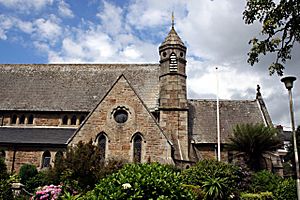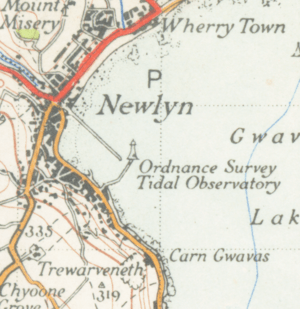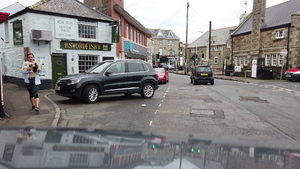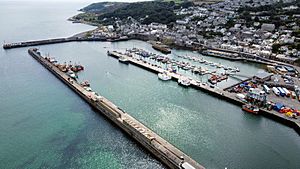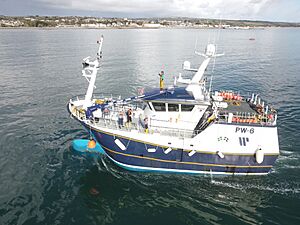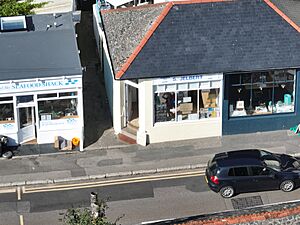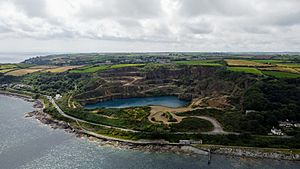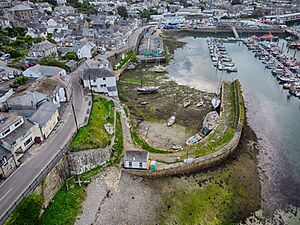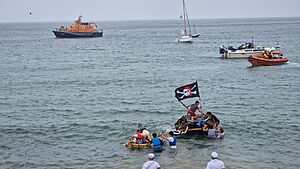Newlyn facts for kids
Quick facts for kids Newlyn
|
|
|---|---|
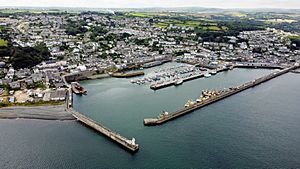 |
|
| Lua error in Module:Location_map at line 530: Unable to find the specified location map definition: "Module:Location map/data/Cornwall (mainland)" does not exist. | |
| Population | 4,432 |
| OS grid reference | SW460283 |
| Civil parish | |
| Unitary authority | |
| Ceremonial county | |
| Region | |
| Country | England |
| Sovereign state | United Kingdom |
| Post town | PENZANCE |
| Postcode district | TR18 |
| Dialling code | 01736 |
| Police | Devon and Cornwall |
| Fire | Cornwall |
| Ambulance | South Western |
| EU Parliament | South West England |
| UK Parliament |
|
Newlyn (Cornish: Lulynn) is a busy seaside town and fishing port. It is located in south-west Cornwall, England. Newlyn is known as the largest fishing port in England.
The town sits on the shore of Mount's Bay. It is very close to the nearby town of Penzance. Fishing is the main job here. However, Newlyn is also a popular place for holidays. You can find many yachts and pleasure boats in its harbour.
Contents
What's in a Name?
The name Newlyn comes from the Cornish language. It means "pool for a fleet of boats." This likely refers to an area offshore called Gwavas Lake. This spot was traditionally where fishing boats would anchor.
A Look Back in Time
Newlyn's story is closely tied to its role as a major fishing port. Fishermen often used the protected waters of Gwavas Lake. This made it a good place to land their catches.
Early History and Attacks
In 1595, a Spanish attack destroyed Newlyn. It also damaged nearby towns like Penzance and Mousehole.
In 1620, the famous ship Mayflower stopped at Newlyn's old quay. It took on water and supplies there. A plaque on the quay marks this event. It suggests Newlyn was the last port the Mayflower visited in England.
In 1755, a huge earthquake in Lisbon caused a tsunami. This giant wave travelled over 600 miles to the Cornish coast. At Newlyn, the sea rose 10 feet in just ten minutes.
Growing Newlyn
Before the 1800s, "Newlyn" only meant the area near the old quay. The part with the fish market was called "Streetanowan." Newlyn actually grew from three smaller villages. These were Tolcarne, Street-an-owan, and Trewarveneth.
Newlyn was once part of the parish of Paul. Villagers would walk up a steep path to worship at Paul Church. An old stone cross used to be on this path. People believed the Cornish sea spirit, Bucca, was linked to this cross.
In 1851, Newlyn got its own church parish, Newlyn St Peter. The church itself was built between 1859 and 1866. It has beautiful artworks inside.
Artists and Protests
In the 1880s, many artists moved to Newlyn. They formed a group known as the Newlyn School. These painters became very famous.
In 1896, Newlyn saw the Newlyn riots. This happened because fishermen from northern England landed fish on a Sunday. Local Cornish fishermen were Methodists. They strongly believed Sundays should be a day of rest.
Since 1915, a special tidal observatory has been in the harbour. It measures the height of the sea every 15 minutes. This data helps the Ordnance Survey map altitudes across Great Britain. The average sea level at Newlyn is used as the main reference point for all maps in the UK.
In 1937, a fishing boat called the Rosebud sailed to London. It carried a petition from villagers. Their homes were at risk from a government plan to clear old buildings.
During World War II, Newlyn was a base for rescue boats. These boats helped people in the sea. The harbour was bombed during the war. A German radio broadcast even claimed a British warship was sunk there!
Newlyn and the Cornish Language
Newlyn, along with nearby Mousehole and Paul, was one of the last places where the Cornish language was spoken. This was likely because of its strong fishing community. Many people from this area helped keep the language alive. Later, scholars like Henry Jenner studied and became good at speaking Cornish.
Where is Newlyn?
Newlyn is in western Cornwall, just south of Penzance. The B3315 road connects it to Land's End. Paul and Mousehole are located to the south.
The Ordnance Survey, which is the UK's mapping agency, uses Newlyn as its main reference point for all heights. This means that all mapped elevations, like contour lines on maps, are based on the average sea level measured at Newlyn. This average was calculated from sea level readings taken every hour between 1915 and 1921.
Newlyn's Economy
Newlyn's economy mainly relies on its harbour and the fishing industry. Newlyn Harbour is the biggest fishing port in England. In the past, many pilchard fish were caught here. Today, some boats still fish for pilchards using modern nets.
Large fishing boats called beam trawlers operate from Newlyn. Most other boats are owned by their captains. The fishing industry can be tough work. The types of fish caught also change with the seasons.
Sports in Newlyn
Newlyn RFC was a rugby club formed in 1894. In 1944, it joined with Penzance RFC to form Penzance and Newlyn RFC. This club is now known as the Cornish Pirates.
Newlyn Non-Athletico FC is a football club started in 1990. They are nicknamed 'The Crab Army' because of Newlyn's fishing connections. Their club crest even features a red crab.
Cornish Wrestling
Cornish wrestling has been a popular sport in Newlyn for hundreds of years. Tournaments were held in various places, including Trewarveneth Farm.
Food and Music Festival
Newlyn hosts the Newlyn Fish Festival. This event features live music and cooking demonstrations. You can also find many stalls selling local food and products.
Famous Places and Art
The UK National Tidal and Sea Level Facility has a tidal observatory in Newlyn. This is where the UK's main reference point for measuring land height is located.
Newlyn became famous in the 1880s and 1890s for its Newlyn School artists' colony. Famous painters like Thomas Cooper Gotch and Henry Scott Tuke lived and worked here. The largest collection of their work is at Penlee House Gallery and Museum in Penzance.
Newlyn is also home to the Newlyn Art Gallery. This gallery displays a collection of modern art.
Well-Known People from Newlyn
- Ray Atkins, artist
- Stanhope Forbes, artist
- Sir Terry Frost, artist
- Thomas Cooper Gotch, painter
- Robert Hichens, a quartermaster on the RMS Titanic
- William Lovett, political activist
- Jack Nowell, rugby player
- Brenda Wootton, singer
- Mark Jenkin, filmmaker
See also
 In Spanish: Newlyn para niños
In Spanish: Newlyn para niños


